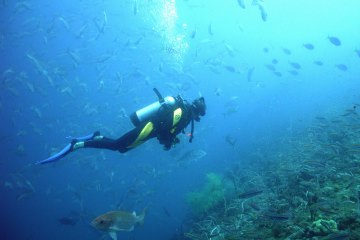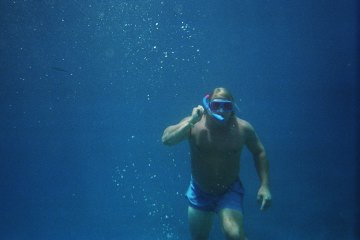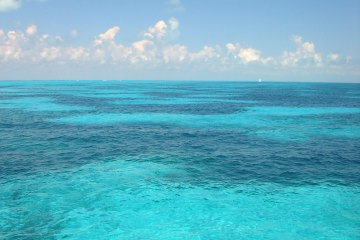Most of the diving in the Xcalak area is divided into two categories. First there is what is referred to as “local diving”. This usually entails diving close to shore along the outer wall of the barrier reef that runs parallel to the waterfront. Travel time to the reefs is usually very short as in most locations the reef is less than ¼ mile offshore. Because Xcalak has been a fishing village for hundreds of years, at some sites there tends to be a shortage of some (popular eating) fish species but there are other areas with an abundance of fish.
You’ll see huge plate and elk horn coral at many locations. Depths can vary but typically do not run extremely deep: generally from 40-75 feet. Surface water conditions tend to be rougher than you would see for resort diving in Cozumel but it’s usually nothing most divers can’t deal with, especially considering the short travel time to the reefs. At most sites, once you get underwater, there is a back and forth surge that can take some getting used to. Visibility is decent but again not as good as in Cozumel. Water temperatures usually run in the upper 70’s to lower 80’s year round although it is not unusual to come across some spots where cold fresh water is escaping from under ground springs that originate on-land.
One of our favorite local dives is known as La Chimenea or The Chimney. The highlight of the dive is a swim down a narrow channel and entry into a large round room with an open top, giving the feeling of looking up through the top of a chimney. When we do it, we like to make our ascent up through this room.
For more information on some other local dives, take a look at the XTC dive shop local diving web page.
The local diving is fun and the short boat rides are convenient but the real attraction for diving in the area is Chinchorro Banks or as it’s known locally, Banco Chinchorro. Depending on where you leave from and which part you’re going to, the atoll at Chinchorro is from 15-20 miles offshore. From Xcalak, it will take you 1 ½ to 2 hours to get there traveling across the open ocean. At times, the seas on the way out there and back can be pretty rough but once you arrive, surface conditions are usually much calmer.
The eastern side of Chinchorro is pounded by the waves of the Caribbean and is where you’ll find the remains of many (but not all) of the hundreds (if not thousands) of ships that have been running aground on this reef system since the Spanish arrived in the 16th Century. The Western side offers much calmer waters and most of the reef dives that Chinchorro is famous for. The area inside the ring is extremely calm and very shallow and typically makes for a better snorkeling than scuba diving spot.
The atoll is in the shape of an oval and stretches over an area of roughly 300 square miles, most of it underwater. There are three main areas of small islands that you’ll find on most maps: Cayo Lobos in the south, Cayo Centro, which is the largest and the two islands of Cayo Norte on the north end. From Xcalak, the nearest of these areas is Cayo Lobos.
There are a huge number of dive sites in the area, many of them unnamed. On one trip we took a few years ago, we made our first dive to a beautiful site full of coral and abundant fish life with a bottom at about 70 feet. We came back to the boat and asked the very experienced boat captain the name of the dive site and he said (with a straight face): “It is 70 foot dive.” On our second dive, we dove to a depth of about 50 feet on another really nice area with rolling mounds of coral separated by sandy channels for as far as we could see. When we returned to the boat and asked the captain the name of the reef, he replied: “It is 50 foot dive.” We didn’t bother to ask the name of the 3rd dive that day.
To be perfectly honest, we don’t feel like we have enough experience at Chinchorro to tell you where the “best” dives are located. We’ve heard about a great snorkel at The Wreck of the 40 Cannons, a 17th century Dutch wreck near Cayo Norte. With a bottom at 12 feet and little current it sounds like a lot of fun.
You should check with your hotel about what dive trips they offer directely but to our knowledge, XTC is the only dive shop in Xcalak that is running day trips out to Chinchorro. They will take a group of a minimum of 4 divers and a maximum of 8 for all Chinchorro trips. Normal departure time is 7:30 AM. A 3-tank trip will run $150 per diver. Snorkelers are charged $75.
There is a third type of diving that is available in the area of Xcalak: Cenote diving. We’ve heard some stories from the guys at Xcalak Caribe Bar and others about trekking back into the jungle with all their gear and making a local cenote dive. One of those stories included a description of the resident alligators. And XTC offers (requiring special arrangement) two tank trips to Cenote Azul in Bacalar.
There are many locations in the area that offer good snorkeling with active animal life within easy swimming distance of the beach. With the water between the shore and the barrier reef rarely more than five feet deep (and never more than fifteen feet deep anywhere), it’s quite easy to stop and stand for a rest or to survey the area on your way out.
If you don’t mind driving a few miles, there is superior snorkeling near the lighthouse about 7 miles north of town where the barrier reef comes very close to shore. After your drive north, you will see the lighthouse and a sand track that leads out to it. You can stop there or stay on the road and a few hundred yards you’ll see another beach where you can pull off the road. You should exercise some care in getting into the water, as there is a lot of coral rock here, which is what makes it such a good snorkel spot.
Virtually anyone with a boat can take you on a snorkel tour. Trips can be organized with XTC, Adolfo at Xcalak Caribe or virtually any of the hotels in the area.



